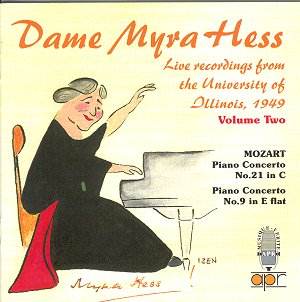 Composer: Myra Hess
Composer: Myra Hess
Works: Piano Concerto No. 21 in C, K467; Piano Concerto No. 9 in E-flat, K271
Performers: Myra Hess, piano; University of Illinois Sinfonietta; John M. Kuypers, conductor
Recording: Live from the University of Illinois, recorded 17 and 18 March 1949
Label: APR 5539
Myra Hess, a pivotal figure in the pantheon of British pianists, is particularly renowned for her interpretations of Mozart. The release of this second volume in the APR series showcases her performances of two Mozart concertos that not only resonate with her interpretative spirit but also reflect the historical context of their creation. The Piano Concerto No. 21, K467, often associated with the grace of the “Elvira Madigan” film, and the exuberant K271, offer a fascinating lens into Hess’s artistry during the late 1940s, a time when her reputation was firmly established yet still evolving in response to the nuances of live performance.
The recording quality, though compromised by the limitations of the original acetate discs, allows us to appreciate the vibrant spontaneity of Hess’s playing. The balance between piano and orchestra is notably skewed, favoring the piano to a point that reveals Hess’s crystalline runs and delicate articulation but often at the expense of orchestral detail. Such imbalances, while frustrating, are a characteristic of live recordings from this era and serve to underscore the immediate connection between the soloist and the audience. Hess’s interpretation of K467 showcases a remarkable flexibility and responsiveness, particularly in her brisk pacing of the opening movement, which contrasts with her more measured approach in earlier recordings, such as her 1942 collaboration with the Hallé Orchestra.
In the slow movement of K467, Hess’s phrasing is marked by a limpid quality that enhances the lyrical beauty of Mozart’s writing. Her expressive touch is complemented by the orchestra, albeit with a somewhat obscured texture. The delightful moment when Hess turns to the audience to inquire about a repeat of the finale is a testament to her infectious engagement with the performance. The use of Denis Matthews’ cadenzas adds an additional layer of interpretative depth, providing both a personal touch and a historical link to the performance practices of the time.
The second work, K271, recorded the following evening, presents an intriguing dynamic between Hess and the University of Illinois Sinfonietta. The orchestra, under John Kuypers, adopts a romanticized phrasing that contrasts with Hess’s more straightforward expressiveness. This tension creates a stimulating interplay that is both engaging and revealing of the interpretative choices at play. While the orchestral sound suffers from murkiness and occasional dropouts, Hess’s playing remains vibrant and compelling, particularly in her phrasing of the second movement, which showcases her ability to balance technical prowess with emotional depth.
Hess’s interpretations in these live recordings offer a captivating glimpse into her artistry. The recording serves as a valuable document of her profound connection to Mozart, despite the sound quality limitations inherent in its age. The restoration of these performances allows for a renewed appreciation of Hess’s contributions to the piano repertoire, especially within the context of her long and storied career. Her ability to navigate the complexities of Mozart’s concertos with both grace and vitality ensures that this release is a significant addition to her discography, illuminating the enduring brilliance of her musicianship.



